冀教版七年级下册13课
- 格式:ppt
- 大小:2.75 MB
- 文档页数:23
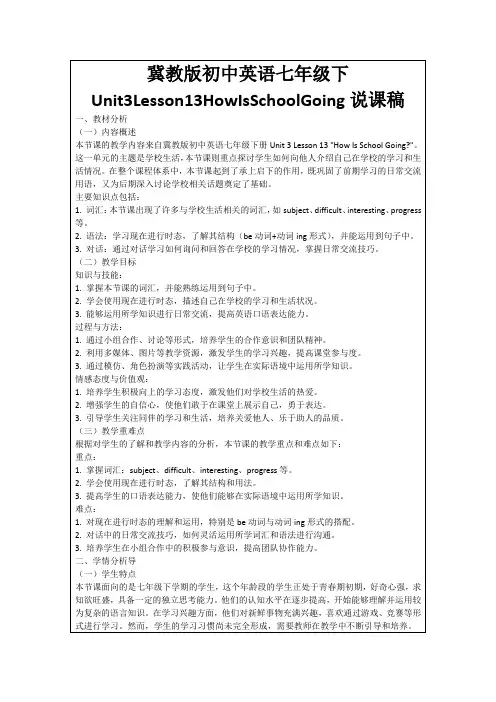

Lesson 13: How Is School Going?[Teaching Aims]Knowledge goals:1.Master the following words: life, term, start, finish, twice, win, social, myselfmon phrases: sport meet, twice a week \ year, long \ high jump, be good at, social studies, by oneselfAbility goal:1 ・ Continue to build up the ability in listening, speaking, reading, writing and translating, especially enable the students to make sentences in English about their school life.Emotion goal:1 ・ Get students to know how to describe their school life correctly・[Important Points 】1 ・ How is ... going?[Difficult Points]How is ... going?[Teaching Aids]Multimedia, radio-tape.【Teaching Procedures ]Step 1 Lead-inShow the students two pictures about their beautiful school and some studentsschool life.Ask and Answer:T: Our school life includes four aspects・ They arc school buildings, people, subjects and activities. Can you say something about these aspects?(The teacher presents the pictures to help students to answer the question.)SI: Teaching Building, Office, Washroom, libraryS2: Our English teacher is Miss Dai.S3: We have math, English, Chinese, music, art and so on.S4: We play basketball after class.T: What do you usually do after class?SI: I usually play football with my classmates.S2: I usually go to the library to read some books.S3:1 usually go to the school yard to take a walk.S4:1 usually have a talk with my friend.(The teacher presents the pictures to help students to answer the question.)Step 2 Aims presentationShow the aims to students and make them know about the aims.Step 3 Learn the new words1.Show pictures to learn new words. At the same time make a sentence with each word・2.Read the words to partners and show in the classStep 4 ListeningT: Play the audiotape for Lesson 13 (How Is School Life Going?) Play it once and ask the students just to listen.T: Play the audiotape a second time and ask the students to answer two questions・T: Cheek the answers as a class.Step 5 ReadingSs: Read the text twice and answer five questions.(1 )How is Jennyschool life going?(2)How many classes docs Wang Mei have every day?(3)What is Wang Mei?s favourite subject?(4)What is Jenny's favourite subject?(5)What did Jenny make in shop class last week?T: Check the answers as a class.Step 6 Language points1.How is ... going?意思是“.... 怎么样?”用来询问对方最近学习、工作、生活等状况。
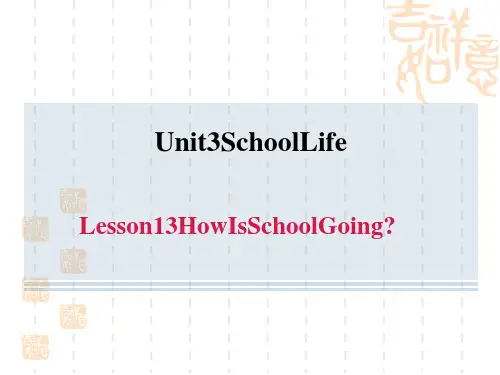



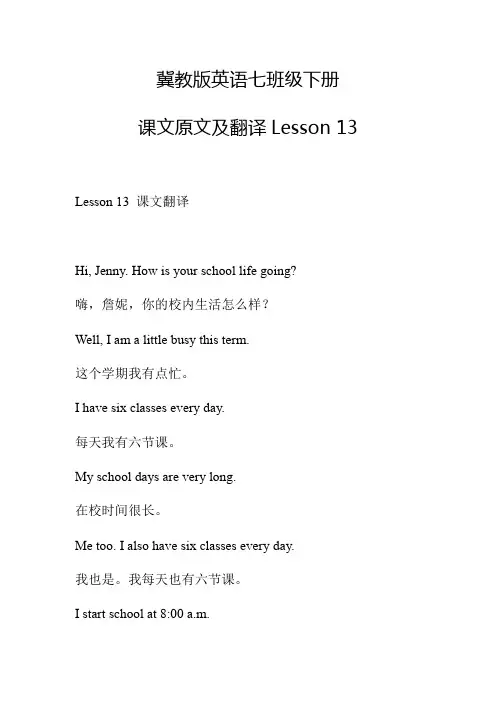
冀教版英语七班级下册课文原文及翻译Lesson 13 Lesson 13 课文翻译Hi, Jenny. How is your school life going?嗨,詹妮,你的校内生活怎么样?Well, I am a little busy this term.这个学期我有点忙。
I have six classes every day.每天我有六节课。
My school days are very long.在校时间很长。
Me too. I also have six classes every day.我也是。
我每天也有六节课。
I start school at 8:00 a.m.我早上八点钟上课。
I usually finish at 5:00 p.m.通常下午五点放学It's a long day, but I like my school.漫长的一天,但是我喜爱我的学校。
My school subjects are so interesting.我们的学科都很好玩。
What subjects do you have?你学哪些课程?I have Chinese, English, math, history and some others.我学习语文,英语,数学,历史和其他科目。
P.E. is my favourite.我最喜爱体育课。
We always have a big sports meet twice a year.我们通常每两年进行一次大型运动会。
I often take part in the long jump.我常常参与跳远活动。
Last term I won first place!上学期我得了第一名!Wow! You're good at the long jump.哇!我擅长跳远。
Yeah! Thank you!是的,感谢!What subjects do you have?你学哪些课程?I have social studies, shop, math, French, English and art.我有社会讨论课,手工艺课,数学课,法语课,英语课和美术课。
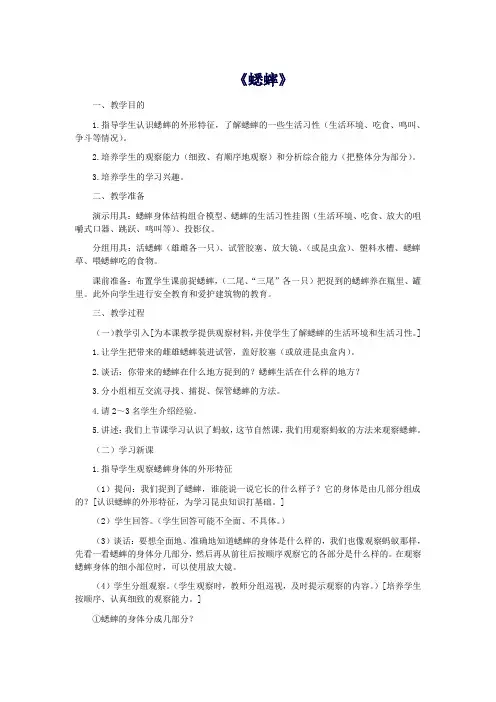
《蟋蟀》一、教学目的1.指导学生认识蟋蟀的外形特征,了解蟋蟀的一些生活习性(生活环境、吃食、鸣叫、争斗等情况)。
2.培养学生的观察能力(细致、有顺序地观察)和分析综合能力(把整体分为部分)。
3.培养学生的学习兴趣。
二、教学准备演示用具:蟋蟀身体结构组合模型、蟋蟀的生活习性挂图(生活环境、吃食、放大的咀嚼式口器、跳跃、鸣叫等)、投影仪。
分组用具:活蟋蟀(雄雌各一只)、试管胶塞、放大镜、(或昆虫盒)、塑料水槽、蟋蟀草、喂蟋蟀吃的食物。
课前准备:布置学生课前捉蟋蟀,(二尾、“三尾”各一只)把捉到的蟋蟀养在瓶里、罐里。
此外向学生进行安全教育和爱护建筑物的教育。
三、教学过程(一)教学引入[为本课教学提供观察材料,并使学生了解蟋蟀的生活环境和生活习性。
]1.让学生把带来的雌雄蟋蟀装进试管,盖好胶塞(或放进昆虫盒内)。
2.谈话:你带来的蟋蟀在什么地方捉到的?蟋蟀生活在什么样的地方?3.分小组相互交流寻找、捕捉、保管蟋蟀的方法。
4.请2~3名学生介绍经验。
5.讲述:我们上节课学习认识了蚂蚁,这节自然课,我们用观察蚂蚁的方法来观察蟋蟀。
(二)学习新课1.指导学生观察蟋蟀身体的外形特征(1)提问:我们捉到了蟋蟀,谁能说一说它长的什么样子?它的身体是由几部分组成的?[认识蟋蟀的外形特征,为学习昆虫知识打基础。
](2)学生回答。
(学生回答可能不全面、不具体。
)(3)谈话:要想全面地、准确地知道蟋蟀的身体是什么样的,我们也像观察蚂蚁那样,先看一看蟋蟀的身体分几部分,然后再从前往后按顺序观察它的各部分是什么样的。
在观察蟋蟀身体的细小部位时,可以使用放大镜。
(4)学生分组观察。
(学生观察时,教师分组巡视,及时提示观察的内容。
)[培养学生按顺序、认真细致的观察能力。
]①蟋蟀的身体分成几部分?②蟋蟀的头部是什么样的?头上长有什么?它们是什么样的?③蟋蟀的身体还长有什么?长在什么部位?什么样子的?(5)学生分组交流、讨论,蟋蟀身体分成几部分、各部分长有什么,是什么样的,观察时还发现什么有趣的现象。
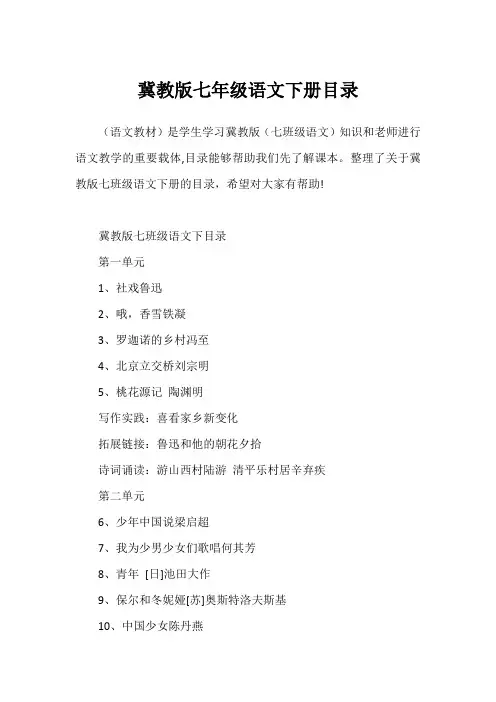
冀教版七年级语文下册目录(语文教材)是学生学习冀教版(七班级语文)知识和老师进行语文教学的重要载体,目录能够帮助我们先了解课本。
整理了关于冀教版七班级语文下册的目录,希望对大家有帮助!冀教版七班级语文下目录第一单元1、社戏鲁迅2、哦,香雪铁凝3、罗迦诺的乡村冯至4、北京立交桥刘宗明5、桃花源记陶渊明写作实践:喜看家乡新变化拓展链接:鲁迅和他的朝花夕拾诗词诵读:游山西村陆游清平乐村居辛弃疾第二单元6、少年中国说梁启超7、我为少男少女们歌唱何其芳8、青年[日]池田大作9、保尔和冬妮娅[苏]奥斯特洛夫斯基10、中国少女陈丹燕写作实践:他们就在生活中综合活动口语交际:我谈流行歌曲诗词诵读:临洞庭上张丞相孟浩然使至塞上王维第三单元11、黄河颂光未然12、梅岭三章陈毅13、护钟梁斌14、人民英雄永垂不朽--瞻仰首都人民英雄纪念碑周定舫15、出师表诸葛亮写作实践:生活中的朵朵浪花拓展链接:历史的丰碑(文化)的宝库诗词诵读:渡荆门送别李白黄鹤楼崔颢第四单元16、蟋蟀[法]法布尔17、蜘蛛周建人18、天鹅[法]布丰18、牛群刘成章19、荔枝图序白居易写作实践:可爱的动植物综合活动口语交际:民风民俗大家谈诗词诵读:酬乐天扬州初逢席上见赠刘禹锡题破山寺后禅院常建第五单元19、庐山云雾江祖凡20、黄陵柏贾平凹21、雨的四季刘湛秋22、大自然的语言竺可桢23、三峡郦道元写作实践:春雨惊春清谷天综合活动口语交际:领略大自然的美丽神奇诗词诵读:饮酒二十首其五陶渊明渔家傲秋思范仲淹第六单元24、鲁智深倒拔垂杨柳施耐庵罗贯中25、龙宫借宝吴承恩26、棋王阿城27、口技林嗣环28、大铁椎传魏禧写作实践:给我留下深刻印象的人拓展链接:神魔皆有人情精魅亦通世故--一部家喻户晓的文学巨著《西游记》诗词诵读:浣溪纱晏殊湖上寓居杂咏姜夔附录一:常见修辞(方法)简表附录二:应用文七班级语文课外描写长江的诗1、江流天地外,山色有无中。
(王维《汉江临眺》)2、大江东去,浪淘尽,千古风流人物。
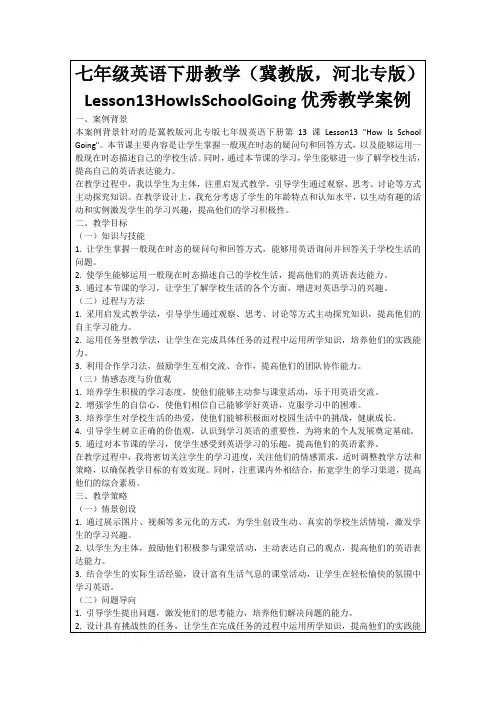
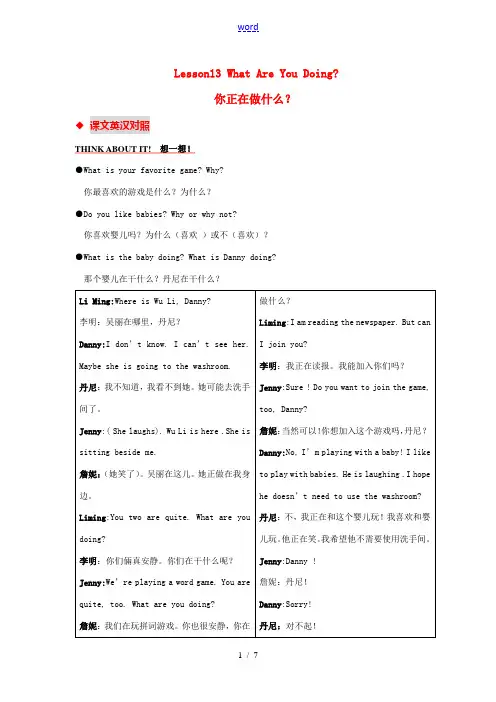
Lesson13 What Are You Doing?你正在做什么?◆课文英汉对照THINK ABOUT IT! 想一想!●What is your favorite game? Why?你最喜欢的游戏是什么?为什么?●Do you like babies? Why or why not?你喜欢婴儿吗?为什么(喜欢)或不(喜欢)?●What is the baby doing? What is Danny doing?那个婴儿在干什么?丹尼在干什么?Li Ming:Where is Wu Li, Danny?李明:吴丽在哪里,丹尼?Danny:I don’t know. I can’t see her. Maybe she is going to the washroom.丹尼:我不知道,我看不到她。
她可能去洗手间了。
Jenny:( She laughs). Wu Li is here .She is sitting beside me.詹妮:(她笑了)。
吴丽在这儿。
她正做在我身边。
Liming:You two are quite. What are you doing?李明:你们倆真安静。
你们在干什么呢?Jenny:We’re playing a word game. You are quite, too. What are you doing?詹妮:我们在玩拼词游戏。
你也很安静,你在做什么?Liming:I am reading the newspaper. But can I join you?李明:我正在读报。
我能加入你们吗?Jenny:Sure ! Do you want to join the game, too, Danny?詹妮:当然可以!你想加入这个游戏吗,丹尼?Danny:No, I’m playing with a baby! I like to play with babies. He is laughing .I hope he doesn’t need to use the washroom?丹尼:不,我正在和这个婴儿玩!我喜欢和婴儿玩。
七年级下册英语教案-Unit3-Lesson13HowIsSchoolGoing(冀教版)(冀教版英语七年级下册) Lesson 13 How Is School Going? 课题How Is School Going? 课时 1 课型new 教学内容分析本教学设计选自英语冀教版七年级下册第三单元第十三课。
本课的教学重难点是词组How is ......going? be good at、take part in、by oneself,频度副词及其用法。
所以本课的授课将采取讲练结合的方式帮助学生攻破难点。
教学目标设计本课教学中渗透了“知识与技能,过程与方法,情感与态度”三种目标。
首先,教给学生基本的知识内容,如什么频度副词。
然后通过对比和相关习题帮助学生掌握对这一知识点的运用。
学生情况分析七年级学生好动、好奇、好表现,应采用形象生动、形式多样的教学方法和学生广泛、积极主动参与的学习方式去激发学生学习的兴趣。
生理上,学生好动,注意力易分散,爱发表见解,希望得到老师的表扬,所以在教学中应抓住学生这一特点,发挥学生的积极性。
设计教学活动时关注整体,层次分明。
教1.Knowledge Goal:① Grasp the new words: life, term, start, finish,twice, win,social, myself②Master the usage of phrases:学目标How is ......going? be good at、take part in、by oneselfMake students be able to distinguish andmake use of the frequency adverbs.2.Ability Goal: By the method of Task-based Language Teachingand pair-work, students get to know the main ideaof the text and use the frequency adverbs fluently.3.Moral Goal: Make students be interested in studying and learnto cooperate with others.重点the new phrases and the frequency adverbs难点Distinguish the five adverbs: always, often, usually, sometimes,never教法Task- based Language Teaching, pair-work教具audiotape, PPT, some pictures for competition教学过程教学步骤教师活动学生活动设计意图新课导入Step I Warming up:(1 minute)Teacher plays the happy songand sing it with students.Step II Leading in: (1 minute)Teacher says: I feel happy. Howdo you feel today?Students sing thehappy song and dothe actions with theteacher.Students answer thequestion voluntarily.It aims tomake theclass activeand lead inthe newlesson.新课教学Step III New words:(5 minutes) life, term, start,finish,twice, win,social, myself Teacher says: Most of us arehappy at school, because there are many subjects we like. Nowplease look at the board and seewhat subjects we have. Teacherplays the PPT.Then teacher shows the newword “shop”Next T shows each new word withthe help of the phonetics. Then teacher check students pronunciation and lead them toread the new words.Game: Teacher shows the newwords on the PPT and asksstudents to have a competition toread the words and get scores fortheir groups.Exercises:(1)We ____ our class at 8 a.m.and _______it at 5 p.m. Today.(2)This year, we ____ thebasketball game and we were Students competeto read the words.Students are notsure if it’s a subject and ask some questions about it. Students read the words by themselves according to the phonetics. Students read the words as soon as possible. And the better group get scores.Students do the exercises according to what they have learnt. Motivatestudents totake part inthe activityand developtheir senseofcooperation. Students findthe questionand ask.Checkstudents’pronunciationand learn thenew words.Help studentsremember thewords.Consolidation新课教学proud of it.(3)______ do _____ homeworkby _______ every day. (I)Step IV Listening (2 minutes) Practice students’listening ability.T shows a picture by PPT to the students and play the audio tape. Step V Reading (5 minutes) Teacher asks the students to read the lesson and answer the questions. Teacher shows the questions by PPT.(1)How is Jenny’s school life going?(2)How many classes does Wang Mei have every day?(3)What is Wang Mei’s favourite subject?(4)What is Jenny’s favourite subject?(5)What did Jenny make in shop class last week?Then teacher checks their answers. (3 minutes)Step VI Text (20 minutes) Explain the whole text, especially the new phrases and the frequency adverbs.(1)New phrases:① How is ___ going?(......怎么样?)Teacher makes use of the sentence in the text to explain the Students listen to itquietly and writedown what subjectsthey have.Students read thetext and answer thequestions on theirown. They can have abrief understanding ofthe text at the sametime.Students listen tothe teacher carefully.Students answer thequestion andunderstand themeaning of thePracticestudents’listeningability andfinish the task.Practicestudents’readingability.Teach thecontentdirectly andmakestudents paymoreattention toit.新课教学phrase.“How is your school life going?”② be good at ......Teacher explains the phrase directly and show the phrase “do well in”for students. And the teacher shows some pictures for students to make sentences on their own.③ take part in④ by oneself(Teach the phrases in the same way.)(2)Frequency adverbs: always, often, usually, sometimes, neverTeacher explains the wordsdirectly with the help of some examples.(Skill: 位置记忆口诀-主谓之间,系表之间,sometimes要除外)①You’re late again. You are always late for school.(埋怨)② They often\ usually go on a trip on holidays.③On weekends, I visit my grandparents sometimes.④ Jenny tries her best to study, so she never fails in her exam.Step VII Consolidation(2 minutes)Fill in the blanks with the correct forms of the words or phrases in the box.life finish subject take part inbe good at(1)I ___ singing. I want to be a singer in the future.(2)I start school at 8 a.m. and phrase.Students listencarefully and makesentences with thenew phrase.Students distinguishthe usage of thefrequency adverbsaccording to teacher’sexplanation.Students do theexercises according tothe knowledge they’velearned on their own.Then, they compete toanswer the question andget scores for theirgroups.To improvestudents’ability ofmaking useof thephrases.Helpstudentsunderstandthedifferencesamong thefrequencyadverbs.Consolidatewhat wehavelearned.___ at 5 p.m.(3)I often ___ the long jump at the sports meet.(4)A: What ___ do you have?B: I have Chinese, English, math and some others.(5)A: How is your school ___ going?B: Well, it’s a little busy.Step VIII Activity (7 minutes)Teacher asks students to have a pair work and have a dialogue practice.A: What subjects do you have? B: ......A: How many classes do you have?B: ......A: When does the first\second... class start?B: ......Step IX Conclusion(1 minute) Teacher leads students to review the knowledge.Step X. Homework(1 minute)①. Recite the new words,phrases and frequency adverbs in Lesson13. (all the students)②. Recite Paragraph 5 .(students after No. 30)③. Retell the content of the text.(Students before No. 30 including No. 30)Students work in pairsand write down theirclass timetable. Then useit to make up a dialogue.Time SubjectStudents say what theyhave learned.Make theatmosphereactive andpracticestudentsspokenEnglish.It’s time forstudents toretell whatthey havelearned.板书设计Lesson 13 How Is School Going?New words: Phrases: Frequency adverbs: life /la?f/ How is ... Going? alwaysterm /t?:m/ be good at oftenstart /stɑ:t/ take part in usuallyfinish /fInI?/ by oneself sometimesnever课堂小结1.回忆本课的主要内容。
一、学习目标1. 学习并掌握重点词汇、短语、句型。
2. 学习谈论学校生活的句式:How is your school life going?3. 熟悉不同频度副词的含义。
4. 学习反身代词的用法。
二、重点、难点重点:1. 单词:start, twice, difference, yourself2. 短语:twice a w eek, be good at, by oneself, on one’s own, give up, drop out of school3. 句型:1)How is your school life going?2)We always have a big sports meet twice a year.3)I want to take part in the fair with my project on the silk worms.难点:1. 不同频度副词的含义。
2. 反身代词的用法。
知识梳理possible adj. 可能的never adv. 从来没有;决不二、重点单词【单词学习】1. start v. 开始;出发【用法】start既可以用作及物动词,也可以用作不及物动词,表示开始某一动作时,后面可接不定式,也可接动名词。
【例句】We start class at 8:00 in the morning. 我们早上八点钟开始上课。
He starts to work at half past eight every day. 他每天八点半开始工作。
【拓展】1. 意为“开始;发生;发起”时,与begin用法相同,两者可互换。
We begin to do our homework.= We start to do our homework. 我们开始写作业。
2. 表示开始某一动作时,后面接不定式或动名词所表达的意思是相同的。
The child began crying/ to cry. 那小孩开始哭了。